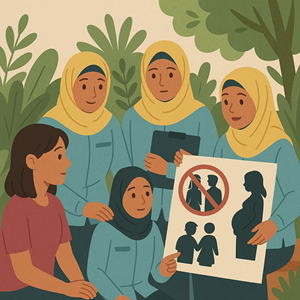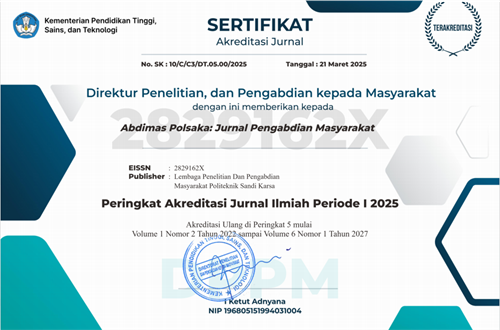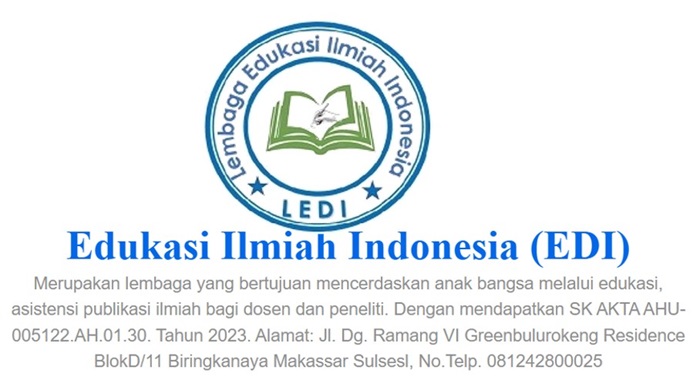Empowerment of youth posyandu cadres as an effort to delay the age of marriage and prevent teenage pregnancy
DOI:
https://doi.org/10.35816/abdimaspolsaka.v4i2.117Keywords:
Adolescent Health Education, Community Service, Early Marriage Prevention, Posyandu Cadres, Teenage PregnancyAbstract
Early marriage and teenage pregnancy remain serious public health issues, as they impact the health of mothers and babies, as well as the social and economic well-being of families. In this regard, integrated health service post (Posyandu) cadres play a crucial role as the spearhead of health education, particularly in providing accurate information to adolescents. This community service program aimed to increase the understanding of adolescent Posyandu cadres, toddler Posyandu cadres, and young women regarding the importance of maturing marriageable age and efforts to prevent teenage pregnancy. The program involved 25 adolescent Posyandu cadres, toddler Posyandu cadres, and young women from Simpang Warga Village, Aluh-Aluh District, Banjar Regency. The implementation phase included a pretest, interactive lecture presentation, a question-and-answer discussion, and a case study related to the phenomenon of teenage pregnancy. A posttest and field evaluation were then conducted to assess the extent of the material's implementation. The data obtained were analyzed descriptively to measure the increase in participants' knowledge. The results showed an increase in average knowledge scores after the intervention. The integrated health post (Posyandu) cadres also demonstrated their readiness to apply the material in youth Posyandu activities, particularly in providing education on the health risks of early marriage. Overall, this community service program has proven effective in strengthening the capacity of Posyandu cadres to support the movement to increase the age of marriage and prevent teenage pregnancy. For the program's sustainability, cross-sector collaboration, including with village governments and community health centers, is needed to strengthen promotive and preventive efforts at the community level.
Downloads
References
I. S. Wahyuni and E. B. Widyaningsih, “Intervention with Fe supplementations and IEC about anemia against hemoglobin levels in female teenagers in state senior high school,” Int. J. Heal. Med. Sci., vol. 4, no. 1, 2021, doi: https://doi.org/10.31295/ijhms.v4n1.500.
Kementerian Kesehatan, Hasil Riset Kesehatan Dasar 2018, vol. 53. 2018.
A. Johariyah and T. Mariati, “Efektivitas Penyuluhan Kesehatan Reproduksi Remaja Dengan Pemberian Modul Terhadap Perubahan Pengetahuan Remaja,” J. Manaj. Kesehat. Yayasan RS.Dr. Soetomo, vol. 4, no. 1, p. 38, 2018, doi: https://doi.org/10.29241/jmk.v4i1.100.
H. Hapisah, R. Rusmilawaty, and R. Rafidah, “Edukasi Dan Pendampingan Calon Pengantin Tentang Kesehatan Keluarga Dan Kesehatan Reproduksi Sebagai Upaya Optimalisasi Persiapan Kesehatan Calon Ibu Di Wilayah Kua Kabupaten Banjar Tahun 2023,” J-ABDI J. Pengabdi. Kpd. Masy., vol. 3, no. 6, pp. 1283–1292, Nov. 2023, doi: https://doi.org/10.53625/jabdi.v3i6.422.
M. Hoque, S. Kader, and E. Hoque, “Prevalence of anaemia in pregnancy in the Uthungulu health district of KwaZulu-Natal, South Africa,” South African Fam. Pract., vol. 49, no. 6, pp. 16-16d, Jul. 2007, doi: https://doi.org/10.1080/20786204.2007.10873568.
H. Mezmur, N. Assefa, and T. Alemayehu, “Teenage Pregnancy and Its Associated Factors in Eastern Ethiopia: A Community-Based Study,” Int. J. Womens. Health, vol. Volume 13, pp. 267–278, Feb. 2021, doi: https://doi.org/10.2147/IJWH.S287715.
L. N. E. S. Andriyani, “Determinants of unintended pregnancy in adolescents (Analysis of data from the 2017 Indonesian demographic health survey),” 2023.
A. Aminatussyadiah, S. F. P. Wardani, and A. N. Rohmah, “Media informasi dan tingkat pendidikan berhubungan dengan kehamilan remaja Indonesia,” J. Kebidanan, vol. 9, no. 2, p. 173, Aug. 2020, doi: https://doi.org/10.26714/jk.9.2.2020.173-182.
M. S. Burn, L. S. Lundsberg, J. F. Culhane, C. Partridge, and M. Son, “Intravenous iron for treatment of iron deficiency anemia during pregnancy and associated maternal outcomes,” J. Matern. Neonatal Med., vol. 36, no. 1, Dec. 2023, doi: https://doi.org/10.1080/14767058.2023.2192855.
H. Tabita et al., “the Effectiveness of Reproductive Health Education Model Among,” Malaysian J. Public Helath Med., vol. 23, no. 2, pp. 237–244, 2023.
H. Hapisah, R. Rafidah, N. Sofia, and M. Mahpolah, “Determinants of Problems in Teenage Pregnancy,” JOSING J. Nurs. Heal., vol. 4, no. 1, pp. 17–24, Oct. 2023, doi: https://doi.org/10.31539/josing.v4i1.7594.
E. Krismawati, B. Widjanarko, and M. . Rahfiludin, “Pengaruh Penggunaan Aplikasi Pengingat Terhadap Kepatuhan Minum Tablet Fe Dan Status Anemia Ibu Hamil: Artikel Review,” J. Ris. GIZI, vol. 9, no. 2, Nov. 2021, doi: https://doi.org/10.31983/jrg.v9i2.6959.
A. R. Fertimah, W. Widyawati, and S. Mulyani, “Efektifitas Penggunaan Media Audiovisual dan Aplikasi Permitasi Terhadap Pengetahuan dan Kepatuhan Ibu Meminum Tablet Besi,” J. Keperawatan Klin. dan Komunitas, vol. 5, no. 3, p. 134, Jan. 2022, doi: https://doi.org/10.22146/jkkk.44276.
A. Ali, A. Khaliq, L. Lokeesan, S. Meherali, and Z. S. Lassi, “Prevalence and predictors of teenage pregnancy in Pakistan: a trend analysis from Pakistan Demographic and Health Survey datasets from 1990 to 2018,” Int. Health, vol. 14, no. 2, pp. 176–182, Mar. 2022, doi: https://doi.org/10.1093/inthealth/ihab025.
R. P. Sari and V. W. Astuti, “Teenage Pregnancy in Indonesia: Determinants and Outcomes,” J. Aisyah J. Ilmu Kesehat., vol. 7, no. 3, 2022, doi: https://doi.org/10.30604/jika.v7i3.1258.
D. Uwizeye, R. Muhayiteto, E. Kantarama, S. Wiehler, and Y. Murangwa, “Prevalence of teenage pregnancy and the associated contextual correlates in Rwanda,” Heliyon, vol. 6, no. 10, p. e05037, Oct. 2020, doi: https://doi.org/10.1016/j.heliyon.2020.e05037.
K. De, “Effect of Socio-Economic Status on Nutritional Status on Adolescent Girls of Paschim Medinipur, West Bengal, India,” Vitam. Miner., vol. 06, no. 01, pp. 4–6, 2017, doi: https://doi.org/10.4172/2376-1318.1000149.
S. Noptriani and D. Simbolon, “Probability of non-compliance to the consumption of Iron Tablets in pregnant women in Indonesia,” J. Prev. Med. Hyg., vol. 63, no. 3, pp. E456–E463, 2022, doi: https://doi.org/10.15167/2421-4248/jpmh2022.63.3.2340.
Hapisah & Rizani Ahmad, “Kehamilan Remaja Terhadap Kejadian Anemia di Wilayah Puskesmas Cempaka Kota Banjarbaru,” J. Vokasi Kesehat., 2015.
S. Nawangsari, R. K. Harahap, H. Al Rasyid, N. Herlina, E. Ekowati, and A. I. Asmarany, “Design of Mobile Digital Healthcare Application For Pregnant Women Based on Android,” MATRIK J. Manajemen, Tek. Inform. dan Rekayasa Komput., vol. 21, no. 2, pp. 439–450, Mar. 2022, doi: https://doi.org/10.30812/matrik.v21i2.1527.
R. D. Wulandari, A. D. Laksono, and R. Matahari, “Teenage Pregnancy in Rural Indonesia: Does Education Level Have a Role?,” J. Promkes, vol. 11, no. 1, pp. 101–108, Mar. 2023, doi: https://doi.org/10.20473/jpk.V11.I1.2023.101-108.
S. Suprapto, D. Arda, M. Kurni Menga, B. Adji Saktiawan, and S. Nggaá Woge, “OPTIMALCARE: Community-based homecare policy innovation in accelerating stunting reduction in Makassar City,” Abdimas Polsaka, vol. 4, no. 2, pp. 148–156, Aug. 2025, doi: https://doi.org/10.35816/abdimaspolsaka.v4i2.107.
S. Suprapto, D. Arda, Y. Tri Wijayanti, and M. K. Fredy Saputra, “Providing education for the community to improve nutrition for toddlers. Abdimas Polsaka, 4 (1), 22–29.” 2025, doi: https://doi.org/10.35816/abdimaspolsaka.v4i1.40

Additional Files
Published
How to Cite
Issue
Section
License
Copyright (c) 2025 Hapisah Hapisah, Rusmilawaty Rusmilawaty, Rafidah Rafidah

This work is licensed under a Creative Commons Attribution 4.0 International License.




















